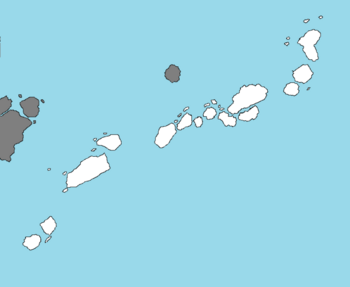Marivista
This article is incomplete because it is pending further input from participants, or it is a work-in-progress by one author. Please comment on this article's talk page to share your input, comments and questions. Note: To contribute to this article, you may need to seek help from the author(s) of this page. |
Federation of Marivista | |
|---|---|
| Motto: "Build and advance as one people" | |
| Anthem: People of the Federation | |
 | |
| Capital | Port of Carpal |
| Largest | Falmington |
| Recognised national languages | English |
| Demonym(s) | Marivistan |
| Government | Parliamentary Republic |
• Prime Minister | Wayan Blechynden |
• President | George Bluenon |
| Legislature | Parliament |
| Independence from Quetana | |
• Unification | 14 March 1958 |
| 23 Decemeber 1973 | |
| Population | |
• 2020 estimate | 820,000 |
• 2022 census | 826,500 |
| GDP (PPP) | 2023 estimate |
• Total | $39,664,560 |
• Per capita | $25,334 |
| GDP (nominal) | 2020 estimate |
• Total | $21,553,090 |
• Per capita | $17,665 |
| Gini (2021) | 39.0 medium |
| HDI | very high |
The Federation of Marivista, commonly known as Marivista, is an island nation in the Northern Cantalle Islands archipelago, located between the Cantalle Ocean and the Ossinia Sea, and sharing maritime borders with Lower Aseu and Ossinia. Having nearly 830,000 inhabitants, it is one of the smallest countries population-wise, with the Port of Carpal being both the capital city of the federation and the most populated city at 70,000 civilians. Marivista is generally considered to be part of the Josette islands.
The islands were inhabited for centuries by indigenous peoples before becoming a colony of the Quetanan Empire in the late 16th century.
In 1956, four island nations separately gained independence from Quetana, and on 14 March, 1958, they would all unite to form the Federation of Marivista, under the leadership of Prime Minister Eric Woanly. In 1973, a bloodless coup d'etat overthrew Woanly, who's government was accused of fraud election results. In 1975, the military handed power over to civilian representatives, who reestablished a parliamentary democracy. Ever since then, the country has remained stable and democratic, especially during the 2010s and into the 2020s with the country being hailed as one of the most free nations on Iearth. In 2023, Hurricane Edith made landfall near Laufrier and killed around 300 civilians, becoming the worst hurricane to ever hit Marivista.
Marivista relies heavily on tourism for its economy, being a tropical island that attracts tourists mainly during the summer. Apart from tourism, agriculture is also a large sector within the federation's small economy. Marivista has been able to sustain a relatively stable economy, being one of the most stable of the Northern Cantalle Islands. The country has also enjoyed a mix of different cultures from across the world, most notably indigenous peoples, descendants of Quetanan colonizers, and slaves from western continents. Marivista is home to a sizeable hip-hop community, as many well-known rappers come from the island. Marivista's culture is also reflected in the annual MariCarnival, which occurs every year on independence day.
History
Indigenous peoples
Quetanan conquest
Quetanan colony
Contemporary era
Geography
Geology
Climate
Biodiversity
Government and politics
Government
Political culture
Administrative divisions
Military
The Marivistan National Defense Force(MNDF) acts as the main military organization in charge of defending the different islands of the federation. It consists of the Defense Guard, the Aerial Guard, and the Coast Guard. Estasblished in 1956 shortly after Marivista's independence from Quetana and unification with the other island states, the military operates a force of just under 5,000 personnel, with most of its defense coming from foreign guarantees.
The mission statement of the Defense Forces is to "defend the sovereignity, territorial integrity, and stability of Marivista and its people, whether in times of peace or times of conflict, and to fulfill any internal or external objectives that help its people to the fullest extent." Marivista's military has been involved in little conflicts, most notable the 1975 Marivistan coup d'etat, as well as several international CCA peacekeeping missions.

